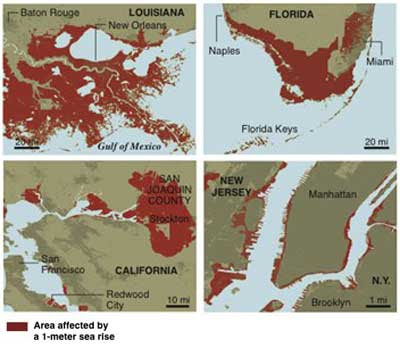Effect of CLimate Change on Coastal Communities

Several scientists at the University of Arizona have produced maps of the effect of a one meter increase in sea level--a level on which there appears to be consensus will occur. Here is a fuller report:
Ultimately, rising seas will likely swamp the first American settlement in Jamestown, Va., as well as the Florida launch pad that sent the first American into orbit, many climate scientists are predicting.
In about a century, some of the places that make America what it is may be slowly erased.
Global warming - through a combination of melting glaciers, disappearing ice sheets and warmer waters expanding - is expected to cause oceans to rise by one meter, or about 39 inches. It will happen regardless of any future actions to curb greenhouse gases, several leading scientists say. And it will reshape the nation.
Rising waters will lap at the foundations of old money Wall Street and the new money towers of Silicon Valley. They will swamp the locations of big city airports and major interstate highways.
Storm surges worsened by sea level rise will flood the waterfront getaways of rich politicians - the Bushes' Kennebunkport and John Edwards' place on the Outer Banks. And gone will be many of the beaches in Texas and Florida favored by budget-conscious students on Spring Break.
That's the troubling outlook projected by coastal maps reviewed by The Associated Press. The maps, created by scientists at the University of Arizona, are based on data from the U.S. Geological Survey.
Few of the more than two dozen climate experts interviewed disagree with the one-meter projection. Some believe it could happen in 50 years, others say 100, and still others say 150.
Sea level rise is "the thing that I'm most concerned about as a scientist," says Benjamin Santer, a climate physicist at the Lawrence Livermore National Laboratory in California.
"We're going to get a meter and there's nothing we can do about it," said University of Victoria climatologist Andrew Weaver, a lead author of the February report from the Intergovernmental Panel on Climate Change in Paris. "It's going to happen no matter what - the question is when."
Sea level rise "has consequences about where people live and what they care about," said Donald Boesch, a University of Maryland scientist who has studied the issue. "We're going to be into this big national debate about what we protect and at what cost."
. . .
All told, one meter of sea level rise in just the lower 48 states would put about 25,000 square miles under water, according to Jonathan Overpeck, director of the Institute for the Study of Planet Earth at the University of Arizona. That's an area the size of West Virginia.
The amount of lost land is even greater when Hawaii and Alaska are included, Overpeck said.
The Environmental Protection Agency's calculation projects a land loss of about 22,000 square miles. The EPA, which studied only the Eastern and Gulf coasts, found that Louisiana, Florida, North Carolina, Texas and South Carolina would lose the most land. But even inland areas like Pennsylvania and the District of Columbia also have slivers of at-risk land, according to the EPA.
Read it all here.

Comments